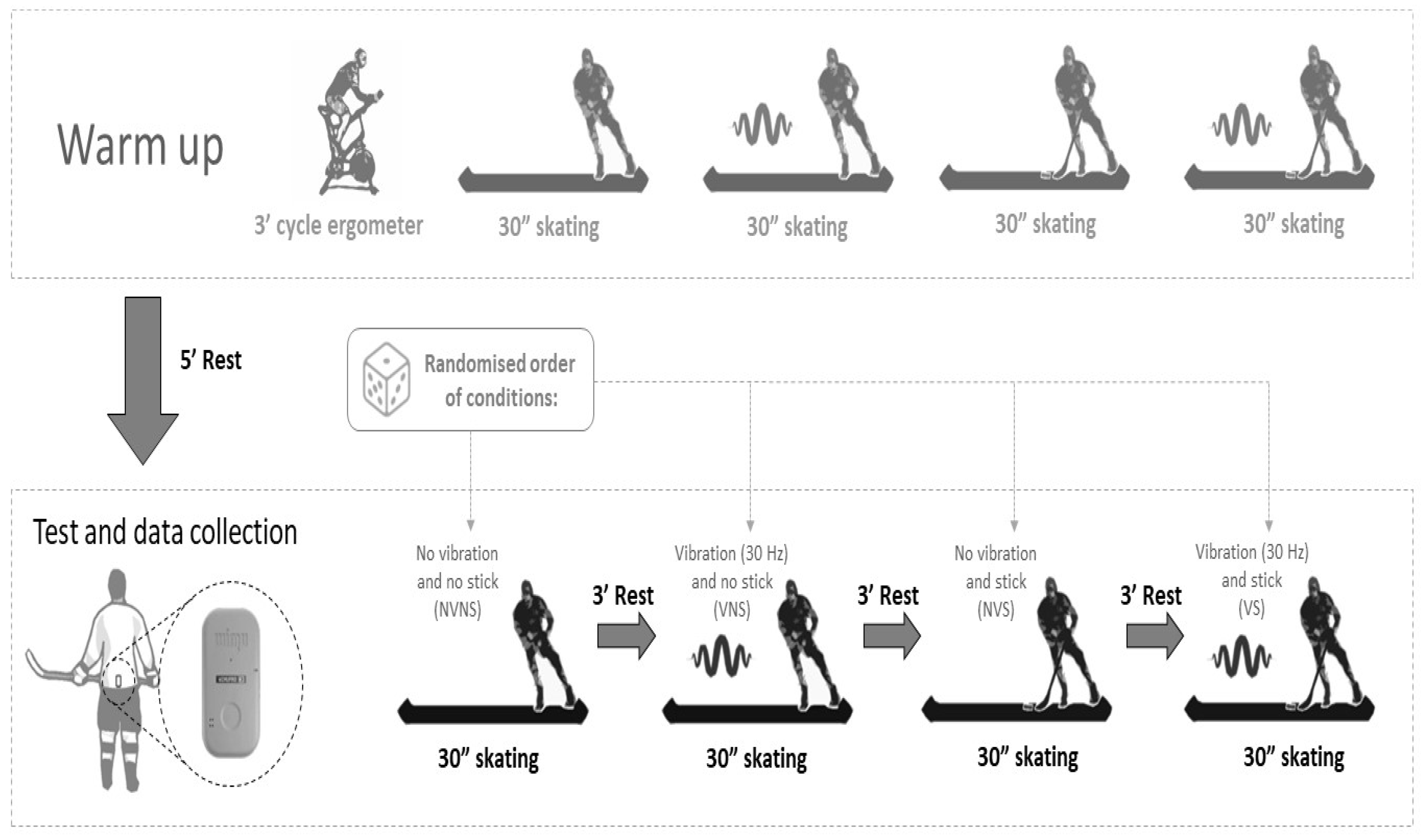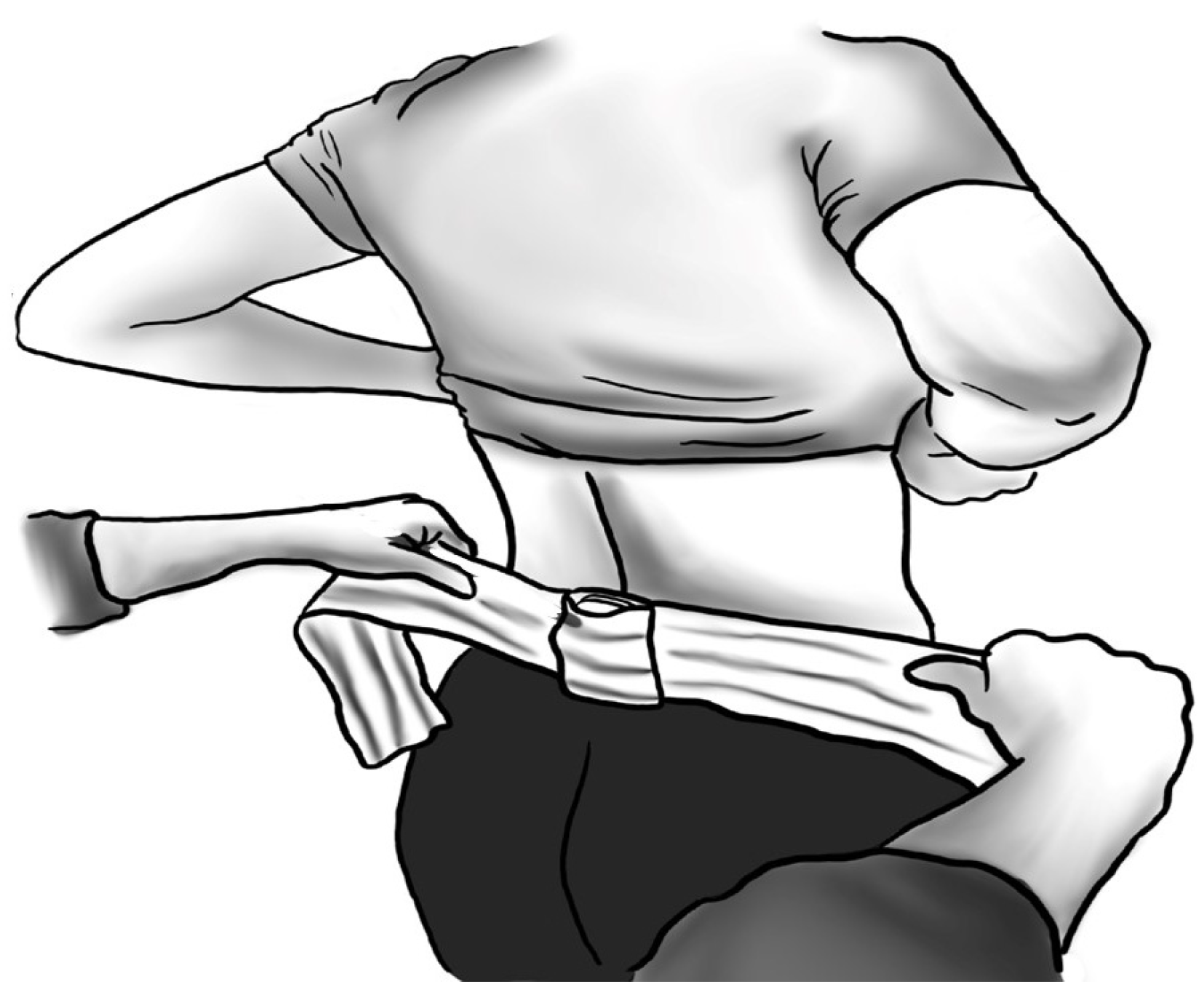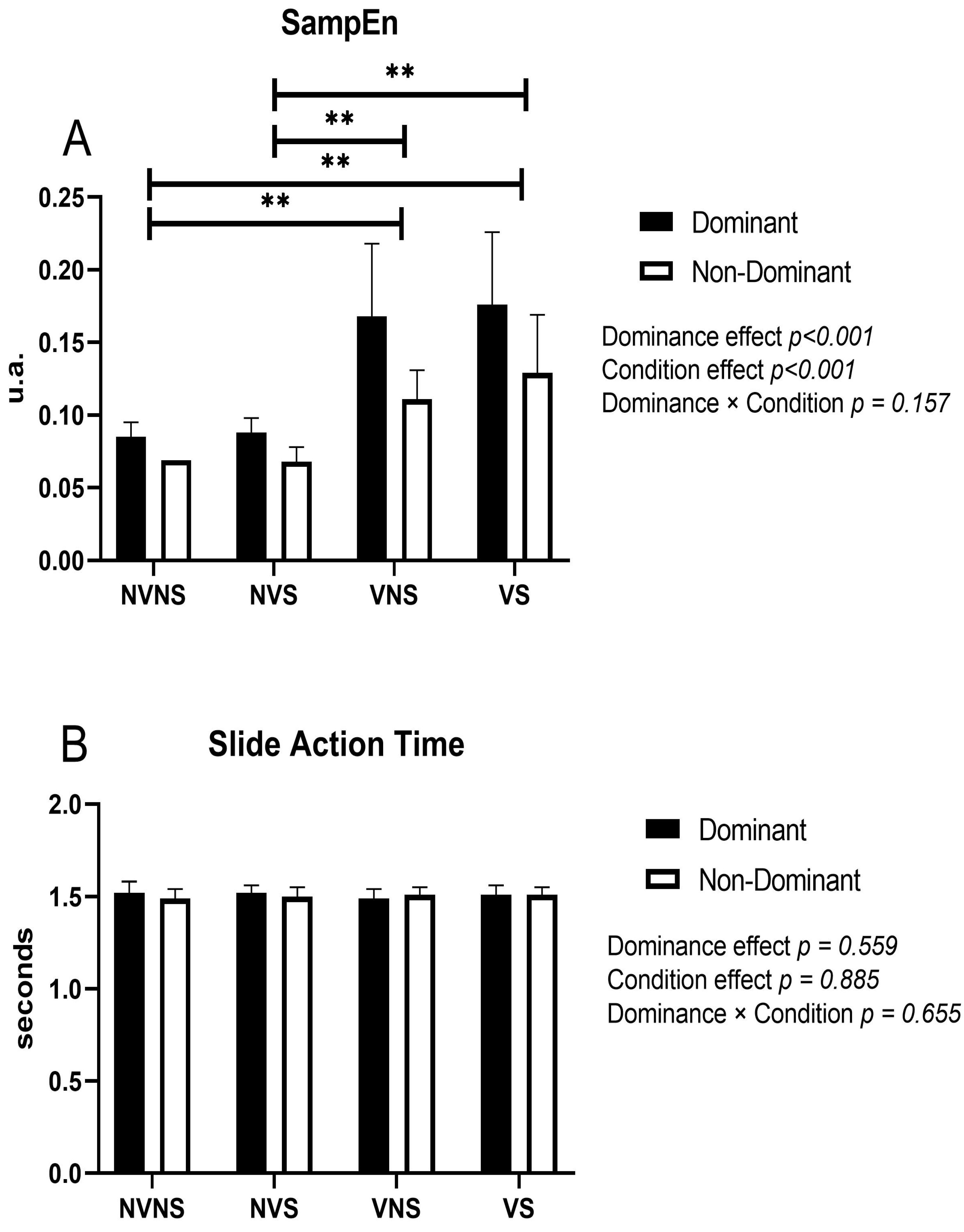Effects of Adding Mechanical Vibration and a Stick on Acceleration and Movement Variability during a Slide-Board Skating Exercise: Differences between the Dominant and Non-Dominant Legs
Abstract
1. Introduction
2. Materials and Methods
2.1. Participants
2.2. Instruments and Tasks
- -
- No vibration and no stick (NVNS): the SB skating exercise was performed without WBV and without the stick implement.
- -
- No vibration with a stick (NVS): the SB skating exercise was performed without WBV and with the stick implement driving a puck.
- -
- Vibration without a stick (VNS): the SB skating exercise was performed with WBV and without the stick implement.
- -
- Vibration with a stick (VS): the SB skating exercise was performed with WBV and with the stick implement driving a puck.
2.3. Experimental Design and Procedures
2.4. Data Collection and Processing
2.5. Statistical Analysis
3. Results
4. Discussion
5. Conclusions
Author Contributions
Funding
Institutional Review Board Statement
Informed Consent Statement
Data Availability Statement
Acknowledgments
Conflicts of Interest
References
- Vigh-Larsen, J.F.; Mohr, M. The physiology of ice hockey performance: An update. Scand. J. Med. Sci. Sports 2022, 34, e14284. [Google Scholar] [CrossRef]
- Cox, M.H.; Miles, D.S.; Verde, T.J.; Rhodes, E.C. Applied physiology of ice hockey. Sports Med. 1995, 19, 184–201. [Google Scholar] [CrossRef]
- Glaister, M. Multiple sprint work: Physiological responses, mechanisms of fatigue and the influence of aerobic fitness. Sports Med. 2005, 35, 757–777. [Google Scholar] [CrossRef] [PubMed]
- Rago, V.; Muschinsky, A.; Deylami, K.; Vigh-Larsen, J.F.; Mohr, M. Game Demands of a Professional Ice Hockey Team with Special Emphasis on Fatigue Development and Playing Position. J. Hum. Kinet. 2022, 84, 195–205. [Google Scholar] [CrossRef] [PubMed]
- Roczniok, R.; Stanula, A.; Maszczyk, A.; Mostowik, A.; Kowalczyk, M.; Fidos-Czuba, O.; Zając, A. Physiological, physical and on-ice performance criteria for selection of elite ice hockey teams. Biol. Sport 2016, 33, 43–48. [Google Scholar] [CrossRef] [PubMed]
- Boland, M.; Delude, K.; Miele, E.M. Relationship between physiological off-ice testing, on-ice skating, and game performance in division I female ice hockey players. J. Strength Cond. Res. 2019, 33, 1619–1628. [Google Scholar] [CrossRef] [PubMed]
- Thompson, K.M.A.; Safadie, A.; Ford, J.; Burr, J.F. Off-ice resisted sprints best predict all-out skating performance in varsity hockey players. J. Strength Cond. Res. 2022. [Google Scholar] [CrossRef]
- Douglas, A.S.; Rotondi, M.A.; Baker, J.; Jamnik, V.K.; Macpherson, A.K. A comparison of on-ice external load measures between subelite and elite female ice hockey players. J. Strength Cond. Res. 2022, 36, 1978–1983. [Google Scholar] [CrossRef] [PubMed]
- Dæhlin, T.E.; Haugen, O.C.; Haugerud, S.; Hollan, I.; Raastad, T.; Rønnestad, B.R. Improvement of ice hockey players’ on-ice sprint with combined plyometric and strength training. Int. J. Sports Physiol. Perform. 2017, 12, 893–900. [Google Scholar] [CrossRef] [PubMed]
- Lee, C.; Lee, S.; Yoo, J. The effect of a complex training program on skating abilities in ice hockey players. J. Phys. Ther. Sci. 2014, 26, 533–537. [Google Scholar] [CrossRef][Green Version]
- Nightingale, S.C.; Miller, S.; Turner, A. The usefulness and reliability of fitness testing protocols for ice hockey players: A literature review. J. Strength Cond. Res. 2013, 27, 1742–1748. [Google Scholar] [CrossRef]
- Piucco, T.; Diefenthaeler, F.; Soares, R.; Murias, J.; Millet, G. Validation of a Maximal Incremental Skating Test Performed on a Slide Board: Comparison with Treadmill Skating. Int. J. Sport Nutr. Exerc. Metab. 2017, 32, 1363–1369. [Google Scholar] [CrossRef] [PubMed]
- Bizzini, M. Optimizing performance in return to play after sport-related concussion in elite ice hockey players: A sports physical therapy and athletic trainer perspective. Int. J. Sports Phys. Ther. 2022, 17, 317. [Google Scholar] [CrossRef] [PubMed]
- Capin, J.J.; Behrns, W.; Thatcher, K.; Arundale, A.; Smith, A.H.; Snyder-Mackler, L. On-ice return-to-hockey progression after anterior cruciate ligament reconstruction. J. Orthop. Sports Phys. Ther. 2017, 47, 324–333. [Google Scholar] [CrossRef] [PubMed]
- Behm, D.; Colado, J.C. The effectiveness of resistance training using unstable surfaces and devices for rehabilitation. Int. J. Sports Phys. Ther. 2012, 7, 226–241. [Google Scholar] [PubMed]
- Zemková, E. Instability resistance training for health and performance. J. Tradit. Complement. Med. 2017, 7, 245–250. [Google Scholar] [CrossRef] [PubMed]
- Marín, P.J.; Hazell, T.J. Effects of whole-body vibration with an unstable surface on muscle activation. J. Musculoskelet. Neuronal Interact. 2014, 14, 213–219. [Google Scholar] [PubMed]
- Sierra-Guzmán, R.; Jiménez, J.F.; Ramírez, C.; Esteban, P.; Abián-Vicén, J. Effects of Synchronous Whole Body Vibration Training on a Soft, Unstable Surface in Athletes with Chronic Ankle Instability. Int. J. Sports Med. 2017, 38, 447–455. [Google Scholar] [CrossRef] [PubMed]
- Sobhani, S.; Sinaei, E.; Motealleh, A.; Hooshyar, F.; Kashkooli, N.S.; Yoosefinejad, A.K. Combined effects of whole body vibration and unstable shoes on balance measures in older adults: A randomized clinical trial. Arch. Gerontol. Geriatr. 2018, 78, 30–37. [Google Scholar] [CrossRef]
- Moras, G.; Fernández-Valdés, B.; Vázquez-Guerrero, J.; Tous-Fajardo, J.; Exel, J.; Sampaio, J. Entropy measures detect increased movement variability in resistance training when elite rugby players use the ball. J. Sci. Med. Sport 2018, 21, 1286–1292. [Google Scholar] [CrossRef]
- Button, C.; Davids, K.; Schollhorn, W.I. Coordination Profiling of Movement Systems; Davids, K., Bennett, S., Newell, K., Eds.; Human Kinetics: Champaign, IL, USA, 2006. [Google Scholar]
- Morral Yepes, M.; Gonzalo-Skok, O.; Fernández Valdés, B.; Bishop, C.; Tuyà, S.; Moras Feliu, G. Assessment of movement variability and time in a football reactive agility task depending on constraints. Sports Biomech. 2023, 1–17. [Google Scholar] [CrossRef]
- Fernández-Valdés, B.; Jones, B.; Hendricks, S.; Weaving, D.; Ramirez-Lopez, C.; Whitehead, S.; González, J.; Gisbert-Orozco, J.; Trabucchi, M.; Moras, G. A novel application of entropy analysis for assessing changes in movement variability during cumulative tackles in young elite rugby league players. Biol. Sport 2023, 40, 161–170. [Google Scholar] [CrossRef]
- Borreani, S.; Calatayud, J.; Martin, J.; Carlos, J.; Tella, V.; Behm, D. Gait & Posture Exercise intensity progression for exercises performed on unstable and stable platforms based on ankle muscle activation. Gait Posture 2013, 39, 404–409. [Google Scholar] [CrossRef]
- Calatayud, J.; Borreani, S.; Martin, J.; Martin, F.; Flandez, J.; Colado, J.C. Gait & Posture Core muscle activity in a series of balance exercises with different stability conditions. Gait Posture 2015, 42, 186–192. [Google Scholar] [CrossRef]
- Busa, M.A.; van Emmerik, R.E.A. Multiscale entropy: A tool for understanding the complexity of postural control. J. Sport Health Sci. 2016, 5, 44–51. [Google Scholar] [CrossRef] [PubMed]
- Couceiro, M.S.; Clemente, F.M.; Dias, G.; Mendes, P.; Fernando, M.L. On an Entropy-based Performance Analysis in Sports. In Proceedings of the 1st International Electronic Conference on Entropy and Its Applications, Virtual, 3–21 November 2014; pp. 1–20. [Google Scholar] [CrossRef]
- Buchecker, M.; Müller, E.; Wegenkittl, S.; Sattlecker, G.; Stöggl, T. An entropy approach for evaluating adaptive motor learning processes while walking with unstable footwear. Hum. Mov. Sci. 2018, 60, 48–56. [Google Scholar] [CrossRef] [PubMed]
- Moras, G.; Vázquez-Guerrero, J.; Fernández-Valdés, B.; Rosas-Casals, M.; Weakley, J.; Jones, B.; Sampaio, J. Structure of force variability during squats performed with an inertial flywheel device under stable versus unstable surfaces. Hum. Mov. Sci. 2019, 66, 497–503. [Google Scholar] [CrossRef]
- Orozco, J.F.G.; Feliu, G.M. A novel slide vibration board for anterior cruciate ligament rehabilitation. Actividad Física y Deporte Ciencia y Profesión 2019, 31, 64–65. [Google Scholar]
- Tuyà Viñas, S.; Fernández-Valdés Villa, B.; Pérez-Chirinos Buxadé, C.; Morral-Yepes, M.; del Campo Montoliu, L.; Moras Feliu, G. Adding mechanical vibration to a half squat with different ballasts and rhythms increases movement variability. PLoS ONE 2023, 18, e0284863. [Google Scholar] [CrossRef]
- Schöllhorn, W.I. Applications of systems dynamic principles to technique and strength training. Acta Acad. Olymp. Est. 2000, 8, 67–85. [Google Scholar]
- Fernández-Valdés, B.; Sampaio, J.; Exel, J.; González, J.; Tous-Fajardo, J.; Jones, B.; Moras, G. The influence of functional flywheel resistance training on movement variability and movement velocity in elite rugby players. Front. Psychol. 2020, 11, 1205. [Google Scholar] [CrossRef]
- Montgomery, P.; Pyne, D.; Minahan, C. The Physical and Physiological Demands of Basketball Training and Competition. Int. J. Sports Physiol. Perform. 2010, 5, 75–86. [Google Scholar] [CrossRef]
- Bastida Castillo, A.; Gómez Carmona, C.D.; Pino Ortega, J.; de la Cruz Sánchez, E. Validity of an inertial system to measure sprint time and sport task time: A proposal for the integration of photocells in an inertial system. Int. J. Perform. Anal. Sport 2017, 17, 600–608. [Google Scholar] [CrossRef]
- Gómez-Carmona, C.D.; Gamonales, J.M.; Pino-Ortega, J.; Ibáñez, S.J. Comparative analysis of load profile between small-sided games and official matches in youth soccer players. Sports 2018, 6, 173. [Google Scholar] [CrossRef]
- Gómez-Carmona, C.D.; Pino-Ortega, J.; Ibáñez, S.J. Design and validity of a field test battery for assessing multi-location external load profile in invasion team sports. E-Balonmano com 2020, 16, 23–48. [Google Scholar]
- Pino-Ortega, J.; Rojas-Valverde, D.; Gómez-Carmona, C.D.; Bastida-Castillo, A.; Hernández-Belmonte, A.; García-Rubio, J.; Nakamura, F.Y.; Ibáñez, S.J. Impact of contextual factors on external load during a congested-fixture tournament in elite U’18 basketball players. Front. Psychol. 2019, 10, 1100. [Google Scholar] [CrossRef] [PubMed]
- Gomez-Carmona, C.D.; Bastida-Castillo, A.; García-Rubio, J.; Ibáñez, S.J.; Pino-Ortega, J. Static and dynamic reliability of WIMU PROTM accelerometers according to anatomical placement. Proc. Inst. Mech. Eng. Part P J. Sports Eng. Technol. 2019, 233, 238–248. [Google Scholar]
- Goldberger, A.L.; Amaral, L.A.N.; Glass, L.; Hausdorff, J.M.; Ivanov, P.C.; Mark, R.G.; Mietus, J.E.; Moody, G.B.; Peng, C.; Stanley, H.E. PhysioBank, PhysioToolkit, and PhysioNet. Circulation 2000, 13, E215–E220. [Google Scholar] [CrossRef] [PubMed]
- Cohen, J. Statistical Power Analysis for the Behavioral Sciences; Routledge Academic: New York, NY, USA, 1988. [Google Scholar]
- Lakens, D. Calculating and reporting effect sizes to facilitate cumulative science: A practical primer for t-tests and ANOVAs. Front. Psychol. 2013, 4, 863. [Google Scholar] [CrossRef]
- Bournival, M.; Martini, G.; Trudeau, F.; Lemoyne, J. The science and art of testing in ice hockey: A systematic review of twenty years of research. Front. Sports Act. Living 2023, 5, 1252093. [Google Scholar] [CrossRef]
- Vescovi, J.D.; Murray, T.M.; Fiala, K.A.; VanHeest, J.L. Off-ice performance and draft status of elite ice hockey players. Int. J. Sports Physiol. Perform. 2006, 1, 207–221. [Google Scholar] [CrossRef]
- Wdowski, M.M.; Gittoes, M.J.R. Kinematic adaptations in sprint acceleration performances without and with the constraint of holding a field hockey stick. Sports Biomech. 2013, 12, 143–153. [Google Scholar] [CrossRef][Green Version]
- Birklbauer, J. Optimal Variability for Effective Motor Learning: A Theoretical Review and Empirical Work on Movement Variability, 1st ed.; Müller, E., Ed.; Meyer & Meyer: Aachen, Germany, 2019. [Google Scholar]
- Wulf, G.; Shea, C.H. Principles derived from the study of simple skills do not generalize to complex skill learning. Psychon. Bull. Rev. 2002, 9, 185–211. [Google Scholar] [CrossRef] [PubMed]
- Promsri, A.; Bangkomdet, K.; Jindatham, I.; Jenchang, T. Leg Dominance—Surface Stability Interaction: Effects on Postural Control Assessed by Smartphone-Based Accelerometry. Sports 2023, 11, 75. [Google Scholar] [CrossRef] [PubMed]
- Promsri, A.; Haid, T.; Federolf, P. How does lower limb dominance influence postural control movements during single leg stance? Hum. Mov. Sci. 2018, 58, 165–174. [Google Scholar] [CrossRef] [PubMed]
- Promsri, A.; Haid, T.; Werner, I.; Federolf, P. Leg dominance effects on postural control when performing challenging balance exercises. Brain Sci. 2020, 10, 128. [Google Scholar] [CrossRef] [PubMed]
- Kapreli, E.; Athanasopoulos, S.; Papathanasiou, M.; Van Hecke, P.; Strimpakos, N.; Gouliamos, A.; Peeters, R.; Sunaert, S. Lateralization of brain activity during lower limb joints movement. An fMRI study. Neuroimage 2006, 32, 1709–1721. [Google Scholar] [CrossRef] [PubMed]
- Aizawa, J.; Hirohata, K.; Ohji, S.; Ohmi, T.; Yagishita, K. Limb-dominance and gender differences in the ground reaction force during single-leg lateral jump-landings. J. Phys. Ther. Sci. 2018, 30, 387–392. [Google Scholar] [CrossRef] [PubMed]
- Wang, Y.; Watanabe, K. Limb dominance related to the variability and symmetry of the vertical ground reaction force and center of pressure. J. Appl. Biomech. 2012, 28, 473–478. [Google Scholar] [CrossRef] [PubMed]
- Oliveira, A.S.; Silva, P.B.; Lund, M.E.; Gizzi, L.; Farina, D.; Kersting, U.G. Effects of perturbations to balance on neuromechanics of fast changes in direction during locomotion. PLoS ONE 2013, 8, e59029. [Google Scholar] [CrossRef]
- Zaidell, L.N.; Mileva, K.N.; Sumners, D.P.; Bowtell, J.L. Experimental evidence of the tonic vibration reflex during whole-body vibration of the loaded and unloaded leg. PLoS ONE 2013, 8, e85247. [Google Scholar] [CrossRef] [PubMed]
- Krause, A.; Gollhofer, A.; Freyler, K.; Jablonka, L.; Ritzmann, R. Acute corticospinal and spinal modulation after whole body vibration. J. Musculoskelet. Neuronal Interact. 2016, 16, 327. [Google Scholar] [PubMed]
- Jacobs, J.V.; Horak, F. Cortical control of postural responses. J. Neural Transm. 2007, 114, 1339–1348. [Google Scholar] [CrossRef] [PubMed]
- Newell, K.M.; Broderick, M.P.; Deutsch, K.M.; Slifkin, A.B. Task goals and change in dynamical degrees of freedom with motor learning. J. Exp. Psychol. Hum. Percept. Perform. 2003, 29, 379. [Google Scholar] [CrossRef]
- Ko, J.-H.; Newell, K.M. Organization of postural coordination patterns as a function of scaling the surface of support dynamics. J. Mot. Behav. 2015, 47, 415–426. [Google Scholar] [CrossRef]
- Williams, G.K.R.; Irwin, G.; Kerwin, D.G.; Hamill, J.; Van Emmerik, R.E.A.; Newell, K.M. Coordination as a function of skill level in the gymnastics longswing. J. Sports Sci. 2016, 34, 429–439. [Google Scholar] [CrossRef]




| Parameters | Dominance Effect | Condition Effect | Dominance × Condition | ||||||
|---|---|---|---|---|---|---|---|---|---|
| Sum of Squares | F | ηp2 | Sum of Squares | F | ηp2 | Sum of Squares | F | ηp2 | |
| Peak AcelT (g) | 2.208 | 31.29 | 0.303 | 0.296 | 1.396 | 0.055 | 0.232 | 1.097 | 0.044 |
| Mean AcelT (g) | 0.000 | 0.293 | 0.004 | 0.020 | 6.017 | 0.200 | 0.001 | 0.296 | 0.012 |
| SampEn (u.a.) | 0.025 | 21.66 | 0.231 | 0.096 | 28.157 | 0.540 | 0.006 | 1.789 | 0.069 |
| Sliding Action Time (s) | 0.001 | 0.345 | 0.005 | 0.002 | 0.216 | 0.009 | 0.004 | 0.543 | 0.022 |
| Parameters | Condition I | Condition II | Mean Differences | p | CI (95%) | |
|---|---|---|---|---|---|---|
| Lower | Upper | |||||
| Peak AcelT (g) | NVNS | NVS | 0.120 | 0.945 | −0.10 | 0.34 |
| VNS | −0.030 | 1.000 | −0.25 | 0.19 | ||
| VS | 0.080 | 1.000 | −0.14 | 0.31 | ||
| NVS | VNS | −0.150 | 0.464 | −0.37 | 0.07 | |
| VS | −0.037 | 1.000 | −0.26 | 0.19 | ||
| VNS | VS | 0.113 | 1.000 | −0.11 | 0.34 | |
| Mean AcelT (g) | NVNS | NVS | 0.021 | 0.259 | −0.06 | 0.05 |
| VNS | −0.021 | 0.259 | −0.05 | 0.00 | ||
| VS | −0.009 | 1.000 | −0.03 | 0.01 | ||
| NVS | VNS | −0.043 | 0.001 ** | −0.07 | 0.01 | |
| VS | −0.030 | 0.028 * | 0.05 | 0.00 | ||
| VNS | VS | 0.012 | 1.000 | 0.01 | 0.04 | |
| SampEn (u.a.) | NVNS | NVS | −0.001 | 1.000 | −0.02 | 0.02 |
| VNS | −0.062 | <0.001 ** | −0.09 | 0.03 | ||
| VS | −0.075 | <0.001 ** | −0.10 | 0.04 | ||
| NVS | VNS | −0.061 | <0.001 ** | −0.09 | −0.03 | |
| VS | −0.074 | <0.001 ** | −0.10 | −0.04 | ||
| VNS | VS | −0.013 | 1.000 | −0.04 | 0.01 | |
| Sliding Action Time (s) | NVNS | NVS | −0.003 | 1.000 | −0.04 | 0.04 |
| VNS | 0.006 | 1.000 | −0.03 | 0.05 | ||
| VS | −0.006 | 1.000 | −0.05 | 0.03 | ||
| NVS | VNS | 0.009 | 1.000 | −0.03 | 0.05 | |
| VS | −0.003 | 1.000 | −0.04 | 0.04 | ||
| VNS | VS | −0.012 | 1.000 | −0.05 | 0.03 | |
Disclaimer/Publisher’s Note: The statements, opinions and data contained in all publications are solely those of the individual author(s) and contributor(s) and not of MDPI and/or the editor(s). MDPI and/or the editor(s) disclaim responsibility for any injury to people or property resulting from any ideas, methods, instructions or products referred to in the content. |
© 2024 by the authors. Licensee MDPI, Basel, Switzerland. This article is an open access article distributed under the terms and conditions of the Creative Commons Attribution (CC BY) license (https://creativecommons.org/licenses/by/4.0/).
Share and Cite
Gisbert-Orozco, J.F.; Moras, G.; Illera-Domínguez, V.; Toro-Román, V.; Pérez-Chirinos Buxadé, C.; Fernández-Valdés, B. Effects of Adding Mechanical Vibration and a Stick on Acceleration and Movement Variability during a Slide-Board Skating Exercise: Differences between the Dominant and Non-Dominant Legs. Appl. Sci. 2024, 14, 1481. https://doi.org/10.3390/app14041481
Gisbert-Orozco JF, Moras G, Illera-Domínguez V, Toro-Román V, Pérez-Chirinos Buxadé C, Fernández-Valdés B. Effects of Adding Mechanical Vibration and a Stick on Acceleration and Movement Variability during a Slide-Board Skating Exercise: Differences between the Dominant and Non-Dominant Legs. Applied Sciences. 2024; 14(4):1481. https://doi.org/10.3390/app14041481
Chicago/Turabian StyleGisbert-Orozco, Jose F., Gerard Moras, Víctor Illera-Domínguez, Víctor Toro-Román, Carla Pérez-Chirinos Buxadé, and Bruno Fernández-Valdés. 2024. "Effects of Adding Mechanical Vibration and a Stick on Acceleration and Movement Variability during a Slide-Board Skating Exercise: Differences between the Dominant and Non-Dominant Legs" Applied Sciences 14, no. 4: 1481. https://doi.org/10.3390/app14041481
APA StyleGisbert-Orozco, J. F., Moras, G., Illera-Domínguez, V., Toro-Román, V., Pérez-Chirinos Buxadé, C., & Fernández-Valdés, B. (2024). Effects of Adding Mechanical Vibration and a Stick on Acceleration and Movement Variability during a Slide-Board Skating Exercise: Differences between the Dominant and Non-Dominant Legs. Applied Sciences, 14(4), 1481. https://doi.org/10.3390/app14041481









